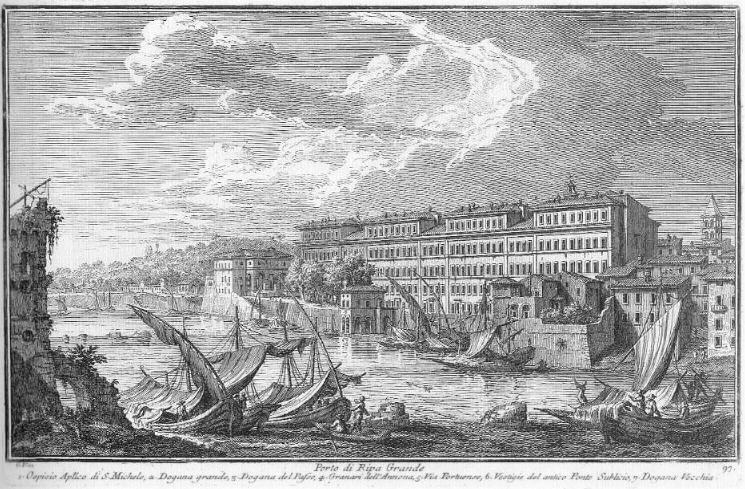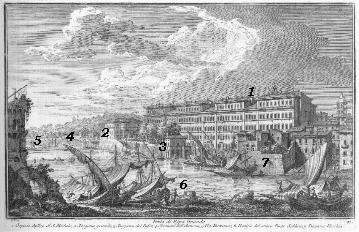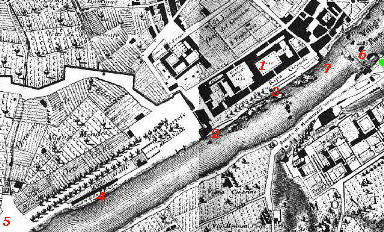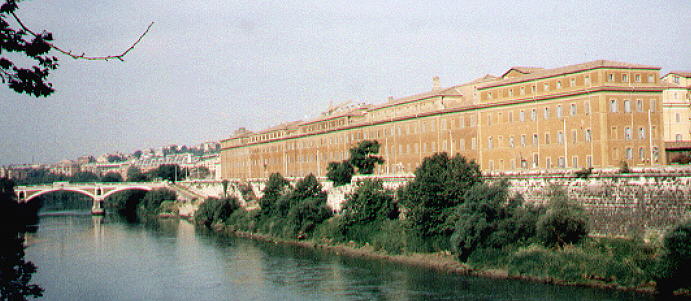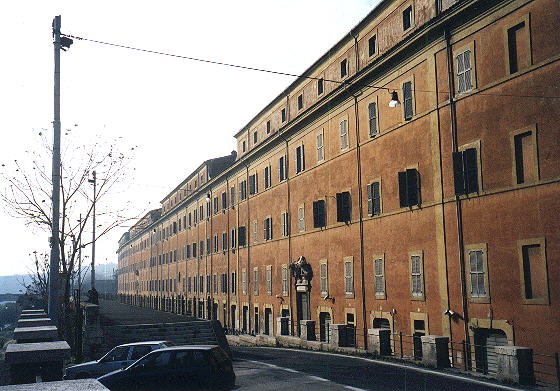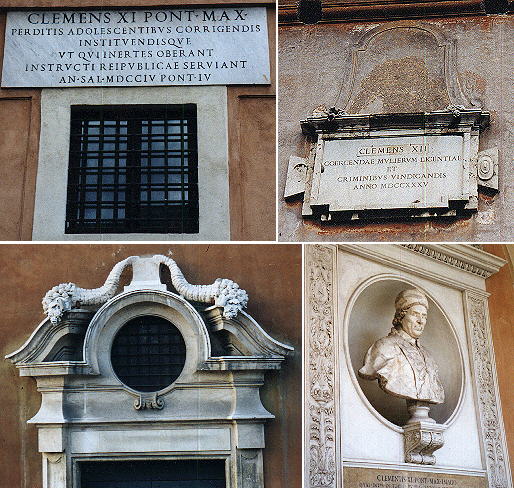

Porto di Ripa Grande (Book
5) (Map
C3) (Day 6) (View C11) (Rione Trastevere)
In this page:
The plate by Giuseppe Vasi
Today's view
Ospizio di S. Michele
The Plate (No. 97)
The traditional way to bring food and commodities to Rome was to
go up the Tiber from Ostia. Ancient Rome had on the left bank large warehouses
to store wheat, oil and marbles coming from the provinces. The Rome of
the Popes built on the right bank the much more limited facilities required
to handle the limited traffic coming from Civitavecchia and Terracina.
Vasi shows Ripa Grande also in plate
98. The view is taken from the green dot in the small 1748 map here below.
In the description below the plate Vasi made reference to: 1) Ospizio di S. Michele;
2) Main custom-house; 3) Custom-house for ships; 4) Granaries; 5) Via Portuense; 6) Ruins of Ponte Sublicio; 7) Old custom-house.
5) and 6) are shown in detail in other pages.
Today
The Tiber lost its use as a way of transit with the building of the
high walls needed to prevent flooding and with the beginning of the railroad
era. The custom-houses were sacrificed to traffic needs: a new bridge (called Sublicio as the old Roman bridge) was built to link Testaccio with Porta Portense. The granaries were pulled down or converted into workshops.
Ospizio
di S. Michele
The very large building overlooking the river was started by Innocentius
XI and expanded by the Popes of the first half of the XVIIIth century.
It served different purposes, from orphanage to reformatory and workhouse.
The coats of arms of the façade are lost, but not some of their decoration.
The inner courtyards retain memories of the Popes (bust of Clemens XI). The window
iron grating that you see as a background for this page pays tribute to that pope too. Today the building hosts Istituto Italiano del Restauro and it is occasionally used for exhibitions.
Excerpts from Giuseppe Vasi 1761 Itinerary related to this page:
Ospizio di s. Michele
Sotto Innocenzo XI. ebbe principio questo grande ospizio l'anno 1686. affine di dare ricovero ai poveri
fanciulli mendicanti per la Città, e di levarli dall'ozio. Perciò vi sono delle botteghe, e maestri per tutte
le arti specialmente de' lavori di lana, e di arazzi; evvi ancora lo studio delle lettere, della musica, e del
disegno colla stamperia di caratteri, e di rami; e per quelli, che non hanno volontà di far bene, vi è la
casa di correzione, con tutte le sorte di gastighi. Clemente XI. accrebbe molto la fabbrica col disegno
di Mattia de' Rossi, e di Francesco Fontana, aggiungendovi l'ospizio de' vecchi, ed invalidi dell'uno, e
dell'altro sesso, eretto, come diremo, nella giornata seguente, da Sisto V. presso ponte Sisto.
E finalmente Clemente XII. vi fece le carceri per le donne insolenti, che meritano la galera, o altra
pena per i loro misfatti. Presedono a questo grande ospizio due Cardinali con alcuni nobili Deputati,
e una famiglia di religiosi delle scuole Pie vi abita per insegnare a quei fanciulli, non solo le lettere, ma
ancora i buoni costumi, ed il santo timor di Dio.
Porta un tal nome quest'ospizio, da una cappella, che quivi era dedicata a s. Michele Arcangelo. Altra
cappella fuvvi ancora dedicata alla ss. Vergine, che da' marinari dicevasi del buon Viaggio; prima
però dicevasi della Torre, per quella, che quì fatta aveva s. Leone IV. circa l'anno 848. per impedire
le scorrerie de' saracini, che spesse volte venivano per fiume a danneggiare la Città. In memoria di ciò, e
per comodo de' marinari fu fatta nel medesimo ospizio una cappella con tre altari, che corrisponde nel
gran
Porto di Ripa Grande
Incontro agli antichi navali fu fatto il moderno sbarco delle navi, che vengono dal mare, per maggiore
comodo dell'abitato di Roma, oggi disceso buona parte nel basso. Il Pontefice Innocenzo XII. dopo aver
fatto ridurre la spiaggia comoda allo sbarco col disegno di Mattia de' Rossi, e di Carlo Fontana, fecevi
ancora la Dogana da riporvi le merci che sogliono pagare il dazio, ed il comodo per i ministri.
|
Next plate in Book 5: Altra
Veduta di Ripa Grande
Next step in Day 6 itinerary: Porta Portese

Go
to  or to Book
5 or to my Home
Page on Baroque Rome or to my Home Page on Rome
in the footsteps of an XVIIIth century traveller.
or to Book
5 or to my Home
Page on Baroque Rome or to my Home Page on Rome
in the footsteps of an XVIIIth century traveller.
|


